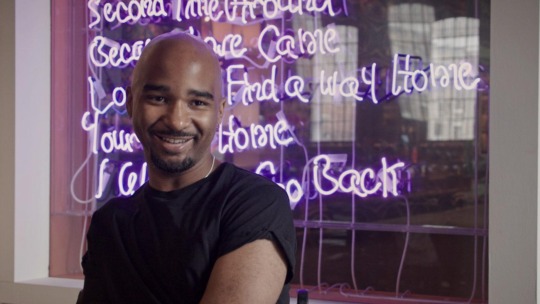I’ve been writing about Wihro Kim intimately for months now, but we’ve only met twice: first, with a flushed, excited “Hello” at the opening of Phantoms and Soft Time (curated by Iman Person at Swan Coach House Gallery, on view through February 14)—which was awkward and shy considering we had been participating in a dream experiment with each other since Thanksgiving, reporting to each other via text message—and then, this morning, when I trekked through the mud in white shoes at the Goat Farm to the studio he shares with artist Addison Adams.
Wihro’s dulcet dreamscapes are fanciful in the way the best wandering thoughts are—close to reality, but warmer, softer, gentler, better. His paintings hover between vague reflection and a complete image capture: move your eyes away too fast, and the person in the painting disappears from view, or fades, or newly appears, an outline shimmering against the trees.
Jasmine Amussen: At the artist talk for Phantoms and Soft Time, you said you were getting used to the idea of having a physical body. How does that physical anxiety or physical unknowing appear in your work?
Wihro Kim: I feel like the thing that moves me to paint exists outside of my body. It uses my body to paint, but I don’t think about my body while I’m working. It’s this other thing, it tells me how to achieve what I need to achieve with the painting. It doesn’t belong to me entirely, and it is something I’m trying to trust more as I age. I’ve tried to put more figures in my work because I think it’s important to look at the physical nature of things.
JA: A lot of your work seems fleeting. Do your paintings hold memory for you?
WK: When I look at certain paintings of mine, I remember vividly the moments I was painting them, the surrounding area, my brother passing by, the sunlight from a window, the music I was listening to. These are not details I tried to remember, but they were the things I saw when I was not looking at the painting, which held an intense concentration. I think it’s something about a mediated experience that allows for the feeling I’m failing to describe. It is a feeling of focus and stepping out of your own thought processes.
JA: Have you worked outside of oil paints, or have any plans to?
WK: I made this painting and decided it was too precious. Sometimes paintings can get precious. Like with the house and the trees and everything, so I decided to start using it as a palette, to see if I could make it less precious, and see how the texture altered it. It made me less afraid, and made it a bit more precious. I feel sometimes that I go from one show to the next, and there isn’t a lot of time. This is something I want to fix in the future, I would like to be more practiced and patient. Sculpture and texture take time.
I asked Wihro if I could take a Polaroid of his studio and him reclining in it. He didn’t say no, but he didn’t exactly say yes: “It’s so strange to see myself in pictures.”
JA: Is it because it’s you recorded as a body?
WK: Yes, and because photography is such a harsh medium.
I disagreed. In these photos, the colors and shapes are diluted and soft. The images are instant, but they have to sit in the dark overnight so the colors set. They are a strange size and shape. Putting memories in a physical object is a small rejection of the digital manipulations of Instagram or Photoshop, or theft.
WK: I think this effect is stronger with photographs, but it could also be present with objects as well. Perhaps objects have the ability to shift more than photographs do. They take on a different significance in that physical, one-of-a-kind, image-object state. The ability to find it again in a book or a secret place. Where is a secret place in regard to digital photography? Perhaps deep in an external hard drive? The feeling is different. Is a digital photograph capable of being moved the way a Polaroid might? There is a a way that things are happenstance and coincidental in flesh life. There is no algorithm yet for that kind of movement in digital spaces. And it is also a different way of tying an image to a moment, I believe. The image was perhaps more created than it was captured.
Paintings by Wihro Kim are on view in the two-person show Phantoms and Soft Time at Swan Coach House Gallery in Atlanta through February 14. Kim will present a solo exhibition at Institute 193 in Lexington in March.
This article features one of the artists participating in Art Crush, BURNAWAY’s upcoming auction and fundraiser, on Saturday, February 16 at The Factory Atlanta in Chamblee. Find out more about this year’s event—which includes a silent auction, interactive installations, live printmaking, and more— and purchase your tickets here.
Wihro Kim’s biggest art crush in the auction is painter Holly Coulis. “I just love the subtle play of plane and surface in her paintings, as well as her use of color,” he says.




